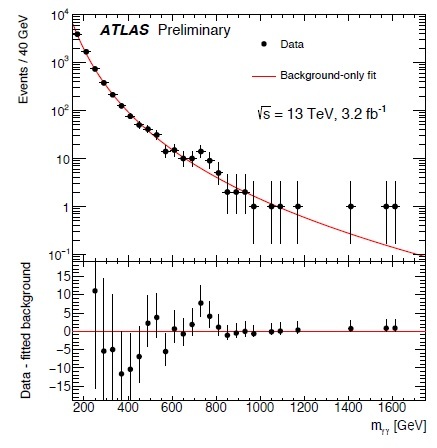Two days ago, CERN presented their new results at 13 TeV to the World. Of course, collected data so far are not enough for conclusive results but the these are exciting anyway. The reason is that both the collaborations, CMS and ATLAS, see a bump at around 750 GeV in the decay. Summing up the results of the two collaborations, they are around
without look elsewhere effect, not yet a discovery but, probably, at the summer conferences they will have something more conclusive to say. This could be an unlucky fluctuation but this situation remember us the story of the discovery of the Higgs boson more than three years ago. The question if this is beyond Standard Model physics is what I will try to answer in these few lines.

Firstly, if this particle is real, it decays with two photons exactly as the Higgs boson. Secondly, with a final state like this it can have only spin 0 or 2. We will be conservative and assume that this is not a graviton. Rather, it is a sibling of the Higgs particle. Besides, it was not observed in run I but is not inconsistent with data from there. It appears like the increased luminosity favored its appearance. We want to be more conservative and we take for granted just the Lagrangian of the Standard Model. So, what is this beast?
My answer is that this could be an excited state of the Higgs boson that, having a production rate lower than its ground state seen at run I, needed more luminosity to be observed. You do not need to change the Lagrangian of the Standard Model for this and it is not BSM physics yet. You do not even need a technicolor theory to describe it. The reason is that the Higgs part of the Standard Model can be treated mathematically yielding exact solutions. The quantum field theory can be exactly solved and the spectrum of the theory says exactly what I stated above (see here, and here). The Higgs model per se is exactly solvable. So, Jester’s idea to add another scalar field to the Lagrangian model is useless, it is all just inside and you will get a two photon final state as well.
Of course, it is too early to draw a final conclusion and a wealth of papers with a prompt explanation flooded arxiv in these two days. With the restart of LHC on spring and the collecting of more data, things will be clearer than now. For the moment, this hint is enough to keep us excited for the next few months.
Marco Frasca (2015). A theorem on the Higgs sector of the Standard Model arxiv arXiv: 1504.02299v2
Marco Frasca (2015). Quantum Yang-Mills field theory arxiv arXiv: 1509.05292v1


If you can solve the equations exactly, does it follow that you can calculate the entire mass spectrum of excited Higgs bosons, either with the 125 GeV Higgs mass in the ground state, or with the 125 GeV ground state and a (presumably first) excited state at 750 GeV?
Dear ohwilleke,
Thanks a lot for pointing out my post about this matter. The idea is that the quantum field theory of the quartic scalar field is exactly solvable when not interacting with other fields and this yields the spectrum of the theory itself. The point is that other fields can change this spectrum, mostly for higher excited states. Anyhow, the spectrum for the Lagrangian of the Higgs field has the form being
being  an integer,
an integer,  and
and  . If you take
. If you take  and fix
and fix  you will get
you will get  , it is not difficult to verify that for
, it is not difficult to verify that for  you will get the right value of mass of 750 GeV. But this just applies to a self-interacting Higgs field without any other field as said.
you will get the right value of mass of 750 GeV. But this just applies to a self-interacting Higgs field without any other field as said.
Marco
Thanks much for the reply.
You are welcome.